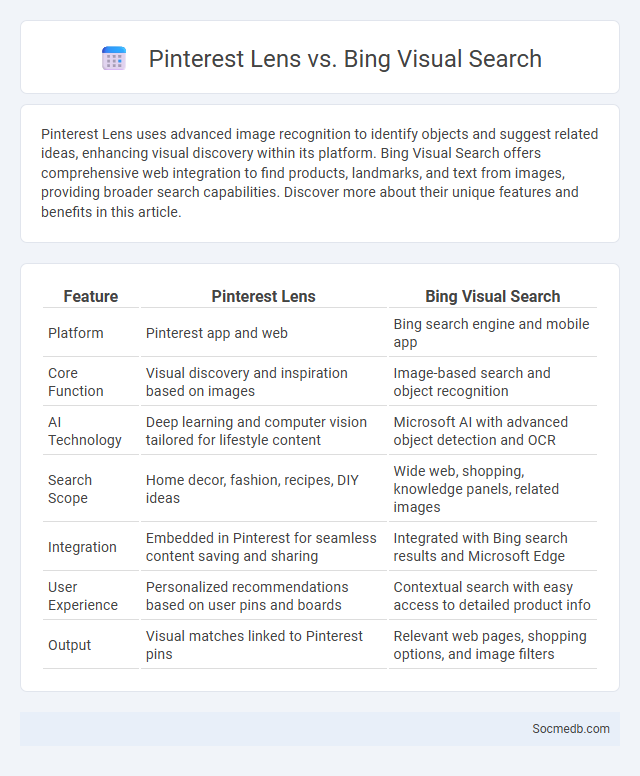
Photo illustration: Pinterest Lens vs Bing Visual Search
Pinterest Lens uses advanced image recognition to identify objects and suggest related ideas, enhancing visual discovery within its platform. Bing Visual Search offers comprehensive web integration to find products, landmarks, and text from images, providing broader search capabilities. Discover more about their unique features and benefits in this article.
Table of Comparison
| Feature | Pinterest Lens | Bing Visual Search |
|---|---|---|
| Platform | Pinterest app and web | Bing search engine and mobile app |
| Core Function | Visual discovery and inspiration based on images | Image-based search and object recognition |
| AI Technology | Deep learning and computer vision tailored for lifestyle content | Microsoft AI with advanced object detection and OCR |
| Search Scope | Home decor, fashion, recipes, DIY ideas | Wide web, shopping, knowledge panels, related images |
| Integration | Embedded in Pinterest for seamless content saving and sharing | Integrated with Bing search results and Microsoft Edge |
| User Experience | Personalized recommendations based on user pins and boards | Contextual search with easy access to detailed product info |
| Output | Visual matches linked to Pinterest pins | Relevant web pages, shopping options, and image filters |
Introduction to Visual Search Technologies
Visual search technologies utilize advanced image recognition algorithms and artificial intelligence to enable users to find content by uploading or capturing images. These tools transform the way you navigate social media platforms by allowing instant identification of products, landmarks, or objects within photos. Integrating visual search enhances user engagement and streamlines access to relevant information through visuals rather than text inputs.
Overview of Pinterest Lens
Pinterest Lens is an advanced visual search tool designed to enhance user discovery by analyzing images captured through a smartphone camera or uploaded from the gallery. Utilizing deep learning and AI technology, Pinterest Lens identifies objects in real-time and delivers relevant pins, product recommendations, and ideas tailored to the visual content. This innovative feature transforms the way users explore inspiration, making visual search on Pinterest highly intuitive and personalized.
Overview of Bing Visual Search
Bing Visual Search leverages advanced AI technology to identify objects, landmarks, and products within images, enhancing your social media experience by allowing seamless content discovery and effortless shopping. The platform supports uploading images or using URLs to quickly find related content, making it a powerful tool for influencers, marketers, and casual users alike. By integrating visual search into social media workflows, you can boost engagement through more interactive and visually-driven searches tailored to your interests.
Overview of Google Lens
Google Lens enables you to explore and interact with the world through your smartphone camera by recognizing objects, text, and landmarks in real-time. This advanced technology uses artificial intelligence and machine learning to provide detailed information, translate languages, and even copy text directly from images. With Google Lens, your social media experience becomes more engaging and informative, as you can seamlessly identify products, discover similar images, and share enriched content.
Core Features Comparison
Social media platforms differ significantly in core features such as content sharing formats, user interaction mechanisms, and privacy controls. Instagram emphasizes visual content with photo and video posts, Stories, and Reels, while Twitter focuses on short text-based updates and real-time news feeds. Facebook offers a broader range of features including groups, events, marketplace, and extensive privacy settings tailored for diverse user engagement.
Visual Recognition Accuracy
Visual recognition accuracy on social media platforms significantly enhances user experience by enabling precise content identification and filtering. Advanced AI algorithms analyze images and videos to detect objects, faces, and scenes with high reliability, improving content recommendations and targeted advertising. Your engagement improves when platforms accurately interpret visual data, ensuring relevant and personalized social media interactions.
User Interface and Experience
Effective social media platforms prioritize intuitive user interfaces (UI) designed to enhance user experience (UX) by offering seamless navigation and engaging visual elements. Optimizing layout simplicity, responsive design, and personalized content delivery ensures Your interaction remains efficient and enjoyable. Constantly evolving UI/UX trends, such as dark mode and interactive stories, contribute significantly to increased user retention and satisfaction.
Integration with Platforms and Apps
Seamless integration with social media platforms and apps enhances your ability to manage content, schedule posts, and track analytics efficiently. Connecting tools like Facebook, Instagram, Twitter, and LinkedIn within one interface streamlines engagement and boosts productivity. This integration ensures real-time updates and synchronized campaigns across multiple channels for maximum impact.
Unique Strengths and Weaknesses
Social media platforms excel in real-time content sharing and community building, enabling instant global connectivity and engagement. Their weaknesses include vulnerability to misinformation spread and privacy concerns, which challenge user trust and platform integrity. Algorithm-driven content can create echo chambers, reducing exposure to diverse perspectives.
Final Verdict: Which Visual Search Tool Wins?
Choosing the best visual search tool depends on factors like accuracy, user interface, and integration with social media platforms. Tools such as Pinterest Lens excel in identifying lifestyle and fashion items, while Google Lens offers broader recognition capabilities across various objects and scenes. To enhance your social media experience, select the tool that aligns with your specific needs for efficient and seamless visual discovery.
 socmedb.com
socmedb.com